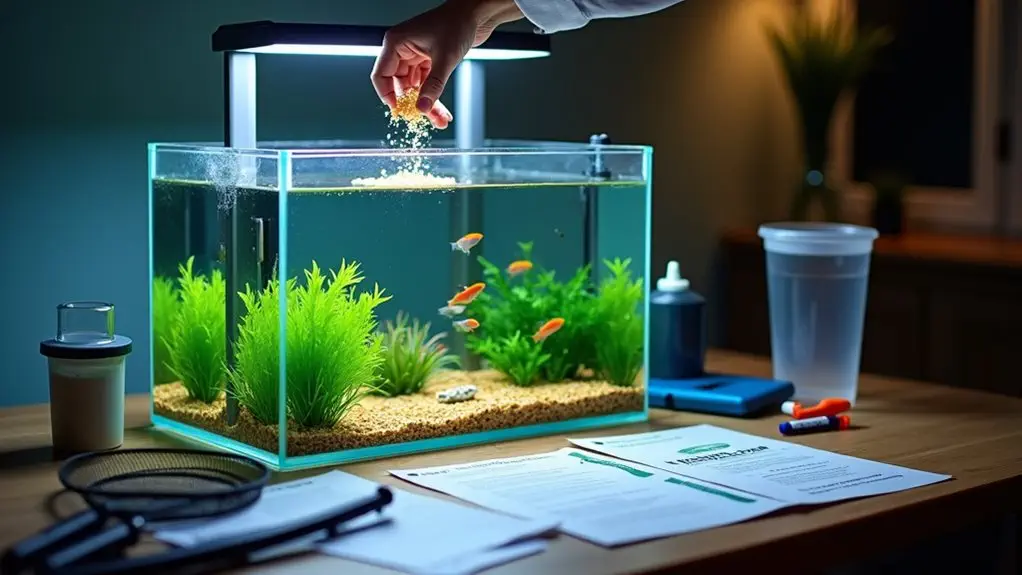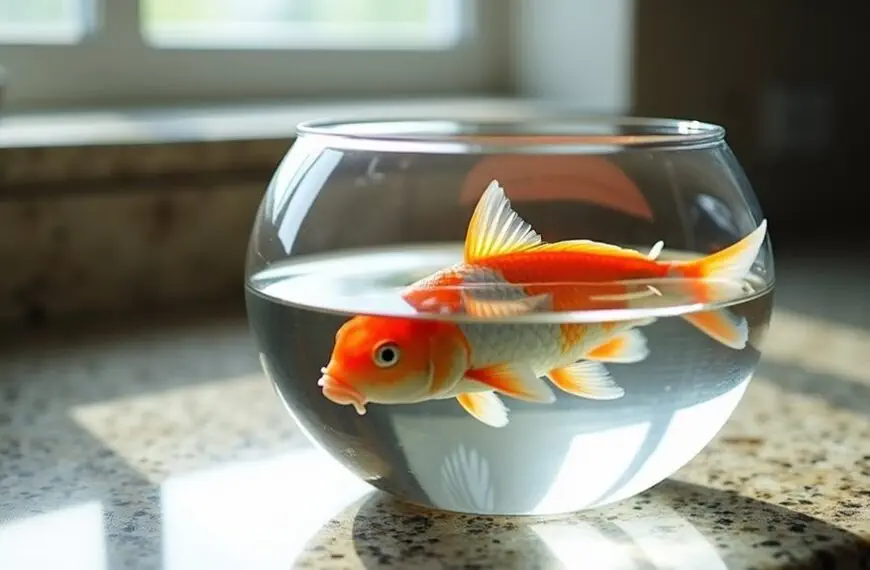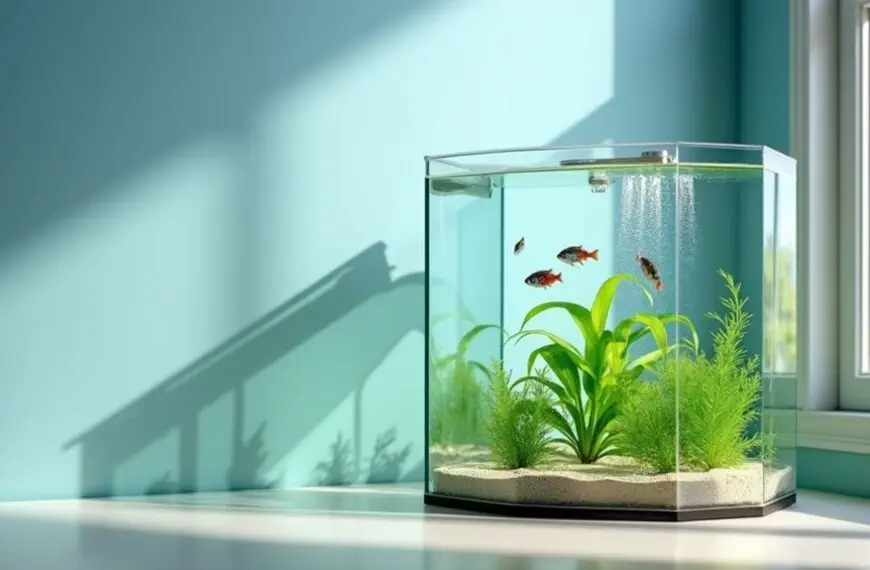Taking care of your first fish doesn't have to be complicated! Start with hardy species like bettas or tetras, and set up a properly sized tank with essential equipment including a filter, heater, and thermometer. You'll need to cycle your tank for 24 hours before adding fish, and maintain water temperatures between 74-77°F. Feed your fish once daily for about 2 minutes, using high-quality flakes or pellets suitable for their species. Perform weekly 10% water changes and monthly 25% changes to keep the water clean. Regular monitoring of water parameters and fish behavior will help you spot any potential issues early on, setting you up for aquarium success.
Contents
- 1 Choosing Your First Fish
- 2 Setting Up The Tank
- 3 Essential Equipment Needed
- 4 Water Quality Management
- 5 Feeding Your Fish
- 6 Common Fish Health Issues
- 7 Tank Cleaning Tips
- 8 Daily Fish Care Routine
- 9 Frequently Asked Questions
- 9.1 Can Fish Recognize Their Owners and Respond to Human Interaction?
- 9.2 How Long Do Different Species of Aquarium Fish Typically Live?
- 9.3 Should I Keep the Aquarium Light on During Nighttime?
- 9.4 What Should I Do With My Fish When Going on Vacation?
- 9.5 Can I Add Decorative Plants From My Garden to the Aquarium?
- 10 Final Thoughts
Choosing Your First Fish
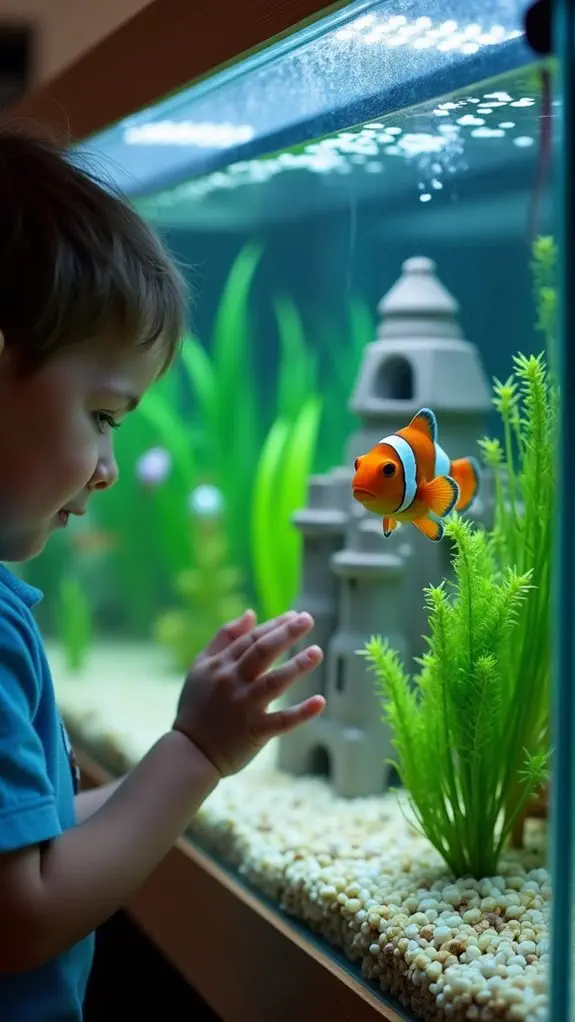
Diving into the world of fish keeping starts with selecting the right fish for your aquarium. As a beginner, you'll want to focus on hardy, easy-to-care-for species that can forgive the occasional beginner's mistake. Species like rasboras, tetras, and betta fish are excellent choices to start your aquatic journey. For optimal health, maintain water changes weekly to keep your aquarium clean and your fish thriving. Most freshwater species need protein-rich diets with 35-45% protein content for proper nutrition. It's important to ensure that your tank setup includes adequate filtration and suitable water conditions for your fish to thrive.
Before you head to the pet store, research fish compatibility to verify your new pets will get along swimmingly (pun intended!). Some fish are natural schooling buddies and need to be in groups of six or more to thrive, while others, like bettas, prefer the solo life.
When selecting your fish, look for active swimmers with bright colors and clear eyes – think of it as fish house-hunting, where you're searching for the healthiest tenants!
Don't forget to evaluate your tank size and the fish's adult size. That tiny fish might look perfect now, but some species can grow surprisingly large.
It's also smart to quarantine new fish before introducing them to your main tank – think of it as a fish version of a two-week notice, verifying everyone stays healthy and happy in their new home.
Setting Up The Tank
Transforming your empty aquarium into a thriving underwater habitat starts with proper setup. When considering tank size considerations, remember that bigger is usually better since it helps dilute waste more effectively and gives your fish plenty of room to swim.
You'll want to place your tank on a sturdy, level surface away from direct sunlight and busy areas of your home – after all, nobody likes nosy neighbors peering in while they're trying to relax! The tank's weight can reach up to 10 pounds per gallon, so ensure your surface can handle the load. The ideal setup requires a budget of around two hundred dollars for essential supplies and equipment.
Before adding water, give your tank and accessories a thorough rinse to remove any dust or debris. For substrate selection, choose materials that'll support your planned ecosystem – whether that's gravel for traditional setups or specialized substrate for live plants.
Once you've added your base layer, it's time to install equipment like filters and heaters, keeping them hidden to maintain the natural look of your aquatic paradise. Installing a reliable filter system is essential for establishing beneficial nitrifying bacteria that will break down waste and toxins in your aquarium.
Finally, fill the tank with room temperature water and add a dechlorinator. Don't rush to add fish right away – you'll need to cycle your tank first, which allows beneficial bacteria to grow. This process typically takes a few weeks, but your future fish friends will thank you for their healthy new home!
Essential Equipment Needed

Now that your tank is properly set up, you'll need the right equipment to keep your aquatic friends healthy and happy. Start with a reliable heater and thermometer – think of it as your fish's personal climate control system! For ideal fish compatibility, you'll want to maintain a cozy temperature between 74-77°F, using about 5 watts per gallon for smaller tanks. A stable aquatic environment is crucial for ensuring your fish thrive.
Your fish's home needs proper filtration too. A quality hang-on or sponge filter will keep the water crystal clear, while an air pump helps create a bubbling paradise that'll make your fish feel like they're at an underwater spa. Using a water conditioner product is essential when adding fresh tap water to remove harmful chlorine and metals. Regular filter media changes help maintain optimal water conditions for your fish.
Don't forget about tank maintenance tools – you'll want a trusty siphon (it's like a vacuum cleaner for your aquarium), an algae scraper, and a dedicated bucket for water changes.
For daily care, grab a medium-sized fishnet (trust me, you don't want to play chase with a tiny net), and invest in a reliable water test kit. By conducting regular tests for ammonia, nitrite, nitrate, and pH levels, you'll better understand your fish's habitat.
These tools aren't just accessories – they're your ticket to becoming a fantastic fish parent who provides a clean, healthy environment for their underwater pals.
Water Quality Management
Water quality stands as the foundation of a healthy aquarium environment. Think of it as creating the perfect home for your finned friends – they'll thank you by staying healthy and active!
To maintain ideal conditions, you'll need to monitor several key parameters regularly, including temperature, oxygen levels, and pH. Different species have unique tolerance ranges, so using local Extension resources can help you determine the ideal parameters for your fish. Regularly checking ammonia levels in addition to the other parameters ensures you're preventing toxicity from building up in the tank.
Start by establishing a routine for water testing to track these essential measurements. You'll want to check temperature and oxygen twice daily, while pH can be monitored once a day. Automatic feeders can help maintain consistent feeding schedules while you focus on water quality checks.
Different fish species have specific parameter ranges they thrive in, so research your particular fish's needs. It's like checking the thermostat in your home – too hot or too cold, and nobody's comfortable!
Make water changes your best friend by replacing 10-15% of the water every two weeks. Don't forget to clean the aquarium walls and vacuum the gravel while you're at it. Regular testing of nitrate levels after water changes can help you monitor the effectiveness of your maintenance.
Keep a simple log of your water test results – it'll help you spot potential problems before they become serious. Remember, maintaining good water quality isn't just about keeping the water clear; it's about creating a thriving underwater world for your pet fish.
Feeding Your Fish
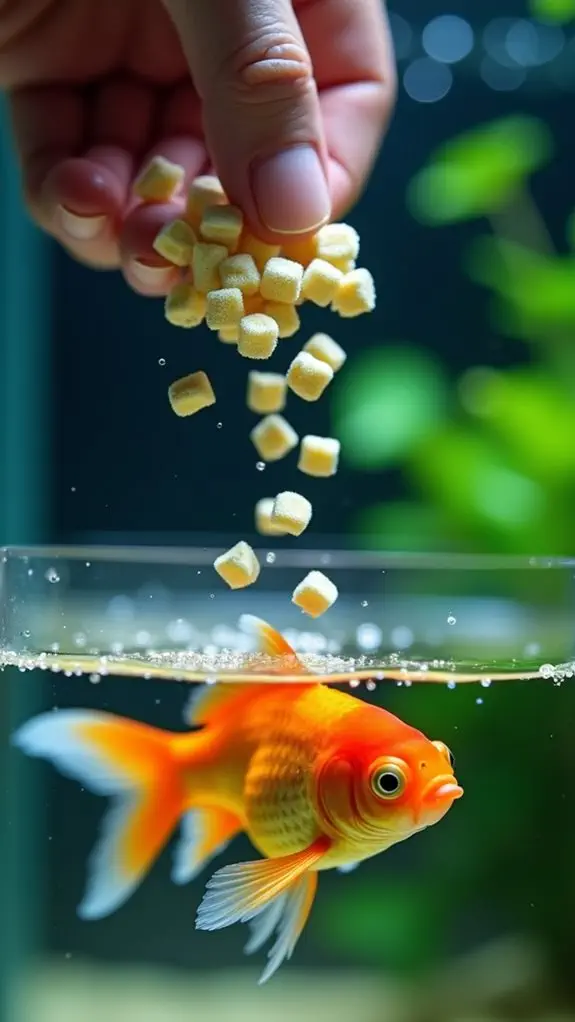
You'll want to start your fish-feeding journey by selecting the right food for your specific fish species, as different fish have unique nutritional needs that you can't ignore. Additionally, providing a diverse diet, including high-quality flakes and pellets, can greatly benefit your fish's overall health.
For optimal distribution, remember to sprinkle food evenly across your tank to ensure all fish, including the less dominant ones, get their fair share.
Setting up a proper feeding schedule is essential, and you'll find that most fish do well with once-a-day feedings that last no longer than two minutes. Your fish can actually survive two weeks without food under normal conditions, so there's no need to panic if you miss a feeding.
While it's tempting to shower your finned friends with lots of food, you'll need to avoid common mistakes like overfeeding, which can lead to poor water quality and unhealthy fish. Monitoring your fish's appetite can help prevent this, ensuring that healthy fish behavior is maintained.
Choosing the Right Food
Feeding your fish the right food is essential for their health and longevity. You'll want to focus on providing nutritional variety through different feeding methods that match your fish's natural eating habits.
If you've got herbivorous fish like mollies or pacus, they'll need plenty of plant-based foods and algae flakes. For carnivorous swimmers, you'll need to serve up protein-rich foods with about 40-55% protein content.
When selecting food, consider your fish's size and eating style. Flakes work great for most small fish, while larger ones might prefer pellets. If you've got bottom feeders, they'll appreciate wafers that slowly dissolve near the tank floor.
Don't forget to mix things up with freeze-dried or frozen foods as occasional treats – think of them as your fish's version of dessert! Maintaining a balanced diet is crucial for promoting your fish's overall health and well-being.
Remember to check the ingredient list on any food you buy, and stick to reputable brands. You'll want to feed your fish once or twice daily, giving them only what they can eat in two to three minutes.
It's better to underfeed slightly than to overfeed – your fish won't mind, and your water will stay cleaner!
Proper Feeding Schedule
Just as important as choosing the right food is knowing when to serve it. Your fish's feeding schedule depends on several factors, including their species, age, and size. Most fish do well with once or twice-daily feedings, but you'll need to adjust your feeding techniques based on your fish's behavior and natural patterns.
When it comes to timing, you'll want to feed most fish about 15 minutes after turning on your aquarium lights. If you've got nocturnal swimmers, like catfish, they'll prefer their dinner after lights-out.
Here's a handy tip: your fish's eye size roughly matches their stomach size – it's nature's built-in portion control! It's also crucial to understand that a varied diet contributes to the overall health of your fish and helps maintain appropriate community dynamics.
Watch how much you're serving, too. You'll know you've got it right when your fish can finish their meal within 2-5 minutes. Young fish are like teenagers – they're always hungry and need more frequent meals, up to 3-5 times daily.
Remember that warmer water speeds up metabolism, so you might need to adjust portions accordingly. The key is to observe your fish's behavior and adjust your feeding schedule to match their natural rhythms.
Avoiding Common Feeding Mistakes
While caring for fish can be rewarding, many new aquarium owners make critical feeding mistakes that can harm their aquatic pets. One of the biggest mistakes you'll want to avoid is overfeeding, which can lead to serious consequences for both your fish and their environment. Your finned friends actually have tiny stomachs, and they only need what they can eat in a few minutes.
You'll need to be mindful of feeding frequency and portion sizes to keep your aquatic pals healthy. If you're noticing uneaten food floating around after five minutes, you're probably giving them too much. Remember, it's better to underfeed than overfeed – your fish won't hold a grudge, we promise!
Make sure you're choosing the right type of food for your specific fish species, as their nutritional needs can vary greatly. Don't forget to remove any leftover food from the tank, and always pre-soak dry food before feeding. Regular water changes help to maintain good water quality and keep your fish swimming happily.
These simple steps will help prevent water quality issues and keep your fish swimming happily. By avoiding these common feeding mistakes, you'll create a healthier environment for your underwater friends.
Common Fish Health Issues
Your fish's health depends on your ability to spot early warning signs like unusual swimming patterns, loss of appetite, or changes in appearance.
When your fish isn't feeling well, you'll need to act quickly with the right treatment, whether it's medication for bacterial infections, parasites, or fungal problems.
The best medicine, though, is prevention, and you'll find that maintaining crystal-clear water quality through regular testing and water changes will keep most health issues at bay. Ensuring optimal ammonia levels is crucial as high concentrations can lead to significant stress and sickness in your fish.
Recognizing Disease Warning Signs
Looking out for signs of illness in your fish can mean the difference between early treatment and serious health complications.
When it comes to disease identification and symptom recognition, you'll want to monitor your fish's behavior and physical appearance daily. If you notice changes in swimming patterns, eating habits, or coloring, it's time to take a closer look.
Here are the key warning signs you shouldn't ignore:
- Physical changes – Watch for white spots, cloudy eyes, or ragged fins that could indicate bacterial or parasitic infections.
- Behavioral shifts – Notice if your fish is hiding more than usual, swimming erratically, or floating sideways.
- Appetite changes – Keep track if your fish isn't eating normally or seems uninterested in food.
- Breathing issues – Look for rapid gill movements or fish gasping at the surface.
Don't panic if you spot these signs, but do take prompt action. Maintaining optimal water parameters can significantly reduce the risk of disease in your aquarium.
Regular tank maintenance and quarantining new fish can prevent many common diseases.
Treatment of Common Ailments
Once you've identified signs of illness in your fish, taking swift action with the right treatment can save their life.
When treating bacterial infections, you'll want to quarantine affected fish and use broad-spectrum fish medications like API E.M. Erythromycin. Remember to remove activated carbon from your filter before adding any medication – it's like making sure your fish actually gets their medicine instead of it being filtered out!
For those pesky parasitic infections (yes, fish can get parasites too!), look for treatments containing copper sulfate or malachite green.
If you notice your fish developing cotton-like growths, you're likely dealing with a fungal infection, which requires specific antifungal treatments and improved water quality for effective disease prevention.
Internal parasites can be particularly troublesome, but don't worry – medications like API General Cure can help.
You'll need to treat twice, about two weeks apart, to guarantee you've tackled both adult parasites and their eggs.
While treating any illness, keep a close eye on your finned friend and maintain pristine water conditions.
Think of it as creating a healing spa environment for your aquatic patient!
Prevention Through Water Quality
Maintaining pristine water quality serves as the foundation for preventing most common fish health issues. Your fish's well-being depends on proper water chemistry and a healthy colony of beneficial bacteria in the tank.
By following a consistent maintenance routine, you'll create a stress-free environment where your aquatic friends can thrive.
Here's what you'll need to do to keep your fish healthy through proper water care:
- Cycle your tank for at least 24 hours before adding fish, allowing beneficial bacteria to establish themselves and create a natural filtration system.
- Test your water weekly for ammonia, nitrates, and pH levels – it's like giving your tank a regular check-up.
- Perform regular water changes: 10% weekly and 25% monthly, making sure to vacuum the gravel and clean decorations.
- Keep pH levels stable between 6.5 and 8.2, and maintain proper alkalinity (120-300 mg/L).
Remember to dechlorinate any new water you're adding to the tank, and don't overcrowd your aquatic space – stick to the one-inch-of-fish-per-gallon rule.
If you notice any changes in water quality, address them promptly to prevent potential health issues from developing.
Tank Cleaning Tips
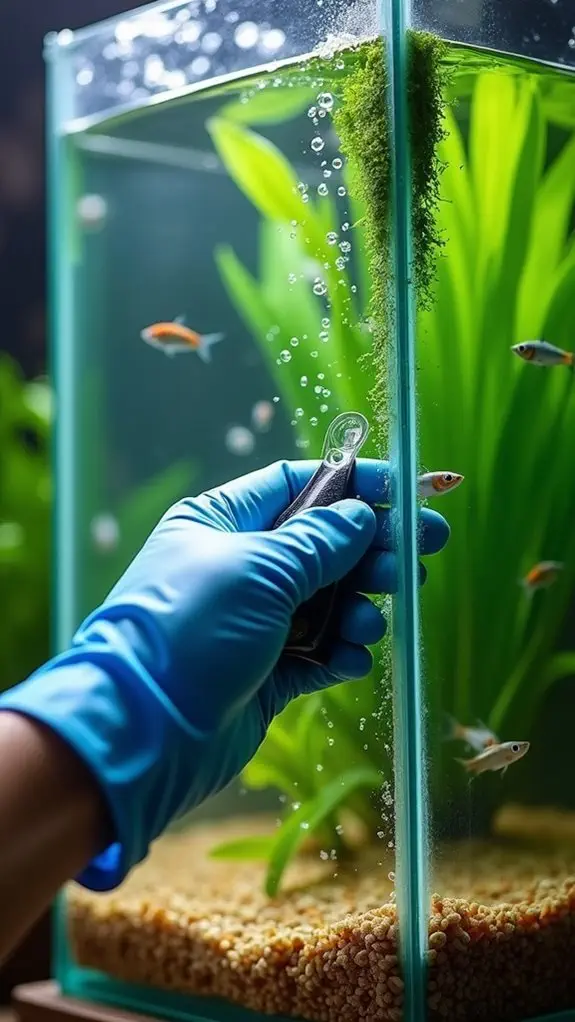
Regular tank cleaning forms the foundation of healthy fish care, but it's crucial to follow proper safety steps before diving in.
Before you start any tank maintenance, unplug all electrical equipment and wash your hands thoroughly up to your elbows – your fish will thank you for keeping their home germ-free!
For effective algae control, you'll want to use an algae scraper on the tank walls and decorations.
Don't forget to vacuum the gravel to remove those pesky food particles and waste that can affect water quality.
When cleaning your filter, here's a pro tip: rinse it in the old tank water you've collected, not tap water, to preserve beneficial bacteria.
Daily Fish Care Routine
Beyond tank cleaning, a consistent daily care routine will keep your fish healthy and thriving.
You'll want to establish regular feeding times and monitor your fish behavior throughout the day, watching how they interact with tank decorations and each other. Remember, a well-maintained schedule helps your fish feel secure and reduces their stress levels.
Here's what your daily fish care routine should include:
- Feed your fish once daily, about 15 minutes after the lights turn on, giving them only what they can eat within 5 minutes.
- Check that your filter's running properly and observe your fish's swimming patterns for any unusual behavior.
- Monitor the water temperature to guarantee it stays stable, and don't forget to look for any debris around tank decorations.
- Spend a few quiet moments watching your fish to spot potential health issues early.
You'll also want to test your water quality daily when you're first starting out.
Once your tank's established, you can switch to weekly testing.
Don't worry if it seems like a lot at first – you'll develop a rhythm that'll become second nature in no time!
Frequently Asked Questions
Can Fish Recognize Their Owners and Respond to Human Interaction?
Yes, your fish can recognize you! Many species demonstrate owner recognition through fish behavior like swimming to the front when you approach. They'll learn your face and movements, responding to regular interactions and feeding patterns.
How Long Do Different Species of Aquarium Fish Typically Live?
You'll find significant lifespan variations among aquarium fish species – from short-lived guppies at 1-2 years to very long-lived koi reaching 60 years. Species differences range dramatically between these extremes.
Should I Keep the Aquarium Light on During Nighttime?
Don't leave your aquarium lighting on at night. It'll disrupt your fish's natural sleep cycle and cause stress. Instead, maintain a consistent 7-10 hour lighting schedule during the day for ideal nighttime effects.
What Should I Do With My Fish When Going on Vacation?
For trips under a week, you can skip feeding. For longer vacations, use an automatic feeder or hire an experienced fish sitter. Make sure you provide detailed instructions and maintain proper tank conditions beforehand.
Can I Add Decorative Plants From My Garden to the Aquarium?
You shouldn't add garden plants directly to your aquarium due to plant safety concerns. They can contain harmful chemicals and pests. Instead, choose aquatic-compatible plants specifically designed for aquarium use.
Final Thoughts
Taking care of your first fish doesn't have to be complicated – you've got this! Remember to maintain consistent water quality, feed appropriately, and stick to your daily care routine. While there's a lot to learn, you'll soon become a natural at spotting when your fishy friend needs attention. With proper setup, the right equipment, and regular maintenance, you'll create a healthy, happy home for your underwater companion.

